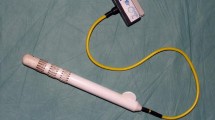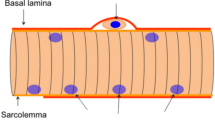Abstract
Purpose
Basic fibroblastic growth factor (bFGF), a member of the heparin-binding growth factor family, regulates muscle differentiation. We investigated whether coadministration of autologous myoblasts and bFGF-loaded polycaprolactone beads could improve sphincter recovery in a dog model of fecal incontinence (FI).
Methods
FI was induced by resecting 25 % of the posterior anal sphincter in ten mongrel dogs. One month later, the dogs were randomized to receive either PKH-26-labeled autologous myoblasts alone (M group, five dogs) or autologous myoblasts and bFGF-loaded polycaprolactone beads (MBG group, five dogs). The outcomes included anal manometry, compound muscle action potentials (CMAPs) of the pudendal nerve, and histology.
Results
The increase in anal contractile pressure over 3 months was significantly greater in the MBG group (from 4.85 to 6.83 mmHg) than that in the M group (from 4.94 to 4.25 mmHg), with a coefficient for the difference in recovery rate of 2.672 (95 % confidence interval [CI] 0.962 to 4.373, p = 0.002). The change in the CMAP amplitude was also significantly greater in the MBG group (from 0.59 to 1.56 mV) than that in the M group (from 0.81 to 0.67 mV) (coefficient 1.114, 95 % CI 0.43 to 1.80, p = 0.001). Labeled cells were detected in 2/5 (40 %) and 5/5 (100 %) dogs in the M and MBG groups, respectively.
Conclusion
Coadministration of bFGF-loaded PCL beads and autologous myoblasts improved the recovery of sphincter function in a dog model of FI and had better outcomes than cell-based therapy alone.





Similar content being viewed by others
References
Brown SR, Wadhawan H, Nelson RL (2013) Surgery for faecal incontinence in adults. Cochrane Database Syst Rev 7:CD001757. doi:10.1002/14651858.CD001757.pub4
Maeda Y, Laurberg S, Norton C (2013) Perianal injectable bulking agents as treatment for faecal incontinence in adults. Cochrane Database Syst Rev 2:CD007959. doi:10.1002/14651858.CD007959.pub3
Kang SB, Lee HN, Lee JY, Park JS, Lee HS, Lee JY (2008) Sphincter contractility after muscle-derived stem cells autograft into the cryoinjured anal sphincters of rats. Dis Colon Rectum 51(9):1367–1373. doi:10.1007/s10350-008-9360-y
Lorenzi B, Pessina F, Lorenzoni P, Urbani S, Vernillo R, Sgaragli G, Gerli R, Mazzanti B, Bosi A, Saccardi R, Lorenzi M (2008) Treatment of experimental injury of anal sphincters with primary surgical repair and injection of bone marrow-derived mesenchymal stem cells. Dis Colon Rectum 51(4):411–420. doi:10.1007/s10350-007-9153-8
Kajbafzadeh AM, Elmi A, Talab SS, Esfahani SA, Tourchi A (2010) Functional external anal sphincter reconstruction for treatment of anal incontinence using muscle progenitor cell auto grafting. Dis Colon Rectum 53(10):1415–1421. doi:10.1007/DCR.0b013e3181e53088
Lee WY, Chang YH, Yeh YC, Chen CH, Lin KM, Huang CC, Chang Y, Sung HW (2009) The use of injectable spherically symmetric cell aggregates self-assembled in a thermo-responsive hydrogel for enhanced cell transplantation. Biomaterials 30(29):5505–5513. doi:10.1016/j.biomaterials.2009.07.006
Oh SH, Kim IG, Lee JY, Lee JY, Lee JH (2011) Bioactive porous beads as an injectable urethral bulking agent: their in vitro evaluation on smooth muscle cell differentiation. Tissue Eng Part A 17(5–6):655–664. doi:10.1089/ten.TEA.2010.0430
Basilico C, Moscatelli D (1992) The FGF family of growth factors and oncogenes. Adv Cancer Res 59:115–165
Fallon JF, Lopez A, Ros MA, Savage MP, Olwin BB, Simandl BK (1994) FGF-2: apical ectodermal ridge growth signal for chick limb development. Science 264(5155):104–107
Niswander L, Martin GR (1993) FGF-4 and BMP-2 have opposite effects on limb growth. Nature 361(6407):68–71. doi:10.1038/361068a0
Riley BB, Savage MP, Simandl BK, Olwin BB, Fallon JF (1993) Retroviral expression of FGF-2 (bFGF) affects patterning in chick limb bud. Development 118(1):95–104
Kang SB, Lee HS, Lim JY, Oh SH, Kim SJ, Hong SM, Jang JH, Cho JE, Lee SM, Lee JH (2013) Injection of porous polycaprolactone beads containing autologous myoblasts in a dog model of fecal incontinence. J Korean Surg Soc 84(4):216–224. doi:10.4174/jkss.2013.84.4.216
Choi JS, Lee SJ, Christ GJ, Atala A, Yoo JJ (2008) The influence of electrospun aligned poly(epsilon-caprolactone)/collagen nanofiber meshes on the formation of self-aligned skeletal muscle myotubes. Biomaterials 29(19):2899–2906. doi:10.1016/j.biomaterials.2008.03.031
Rando TA, Blau HM (1994) Primary mouse myoblast purification, characterization, and transplantation for cell-mediated gene therapy. J Cell Biol 125(6):1275–1287
Schenk HC, Krampfl K, Baumgartner W, Tipold A (2012) Canine muscle cell culture and consecutive patch-clamp measurements - a new approach to characterize muscular diseases in dogs. BMC Vet Res 8:227. doi:10.1186/1746-6148-8-227
Lim SM, Lee HJ, Oh SH, Kim JM, Lee JH (2009) Novel fabrication of PCL porous beads for use as an injectable cell carrier system. J Biomed Mater Res B Appl Biomater 90(2):521–530. doi:10.1002/jbm.b.31313
Nandivada P, Nagle D (2014) Surgical therapies for fecal incontinence. Curr Opin Gastroenterol 30(1):69–74. doi:10.1097/MOG.0000000000000029
Saihara R, Komuro H, Urita Y, Hagiwara K, Kaneko M (2009) Myoblast transplantation to defecation muscles in a rat model: a possible treatment strategy for fecal incontinence after the repair of imperforate anus. Pediatr Surg Int 25(11):981–986. doi:10.1007/s00383-009-2454-3
Tomita M, Lavik E, Klassen H, Zahir T, Langer R, Young MJ (2005) Biodegradable polymer composite grafts promote the survival and differentiation of retinal progenitor cells. Stem Cells 23(10):1579–1588. doi:10.1634/stemcells. 2005-0111
Ochi K, Chen G, Ushida T, Gojo S, Segawa K, Tai H, Ueno K, Ohkawa H, Mori T, Yamaguchi A, Toyama Y, Hata J, Umezawa A (2003) Use of isolated mature osteoblasts in abundance acts as desired-shaped bone regeneration in combination with a modified poly-DL-lactic-co-glycolic acid (PLGA)-collagen sponge. J Cell Physiol 194(1):45–53. doi:10.1002/jcp.10185
Oh SH, Lee JH (2013) Hydrophilization of synthetic biodegradable polymer scaffolds for improved cell/tissue compatibility. Biomed Mater 8(1):014101
Miyasaka EA, Raghavan S, Gilmont RR, Mittal K, Somara S, Bitar KN, Teitelbaum DH (2011) In vivo growth of a bioengineered internal anal sphincter: comparison of growth factors for optimization of growth and survival. Pediatr Surg Int 27(2):137–143. doi:10.1007/s00383-010-2786-z
Kudla AJ, John ML, Bowen-Pope DF, Rainish B, Olwin BB (1995) A requirement for fibroblast growth factor in regulation of skeletal muscle growth and differentiation cannot be replaced by activation of platelet-derived growth factor signaling pathways. Mol Cell Biol 15(6):3238–3246
Jump SS, Childs TE, Zwetsloot KA, Booth FW, Lees SJ (2009) Fibroblast growth factor 2-stimulated proliferation is lower in muscle precursor cells from old rats. Exp Physiol 94(6):739–748. doi:10.1113/expphysiol.2008.046136
Anderson JE, Mitchell CM, McGeachie JK, Grounds MD (1995) The time course of basic fibroblast growth factor expression in crush-injured skeletal muscles of SJL/J and BALB/c mice. Exp Cell Res 216(2):325–334. doi:10.1006/excr.1995.1041
Iwata Y, Ozaki N, Hirata H, Sugiura Y, Horii E, Nakao E, Tatebe M, Yazaki N, Hattori T, Majima M, Ishiguro N (2006) Fibroblast growth factor-2 enhances functional recovery of reinnervated muscle. Muscle Nerve 34(5):623–630. doi:10.1002/mus.20634
Lefaucheur JP, Sebille A (1995) Basic fibroblast growth factor promotes in vivo muscle regeneration in murine muscular dystrophy. Neurosci Lett 202(1–2):121–124
Goldfarb M (2005) Fibroblast growth factor homologous factors: evolution, structure, and function. Cytokine Growth Factor Rev 16(2):215–220. doi:10.1016/j.cytogfr.2005.02.002
Hagege AA, Carrion C, Menasche P, Vilquin JT, Duboc D, Marolleau JP, Desnos M, Bruneval P (2003) Viability and differentiation of autologous skeletal myoblast grafts in ischaemic cardiomyopathy. Lancet 361(9356):491–492. doi:10.1016/S0140-6736(03)12458-0
Acknowledgments
The authors thank Myong Hoon Ihn, Jung-Woo Park, Ok-Sun Kim, Sang A Lee, Tae-Ho Kim, Jun-Gu Kang, and Hye-Jin Kim for their assistance and advice.
Conflicts of interest
The authors have no conflicts of interest to report. This work was supported by a grant from the Korean Health Technology R&D Project, The Ministry of Health and Welfare, Republic of Korea (Grant No. A120357).
Research involving human participants and/or snimals (ethical approval)
All applicable international, national, and/or institutional guidelines for the care and use of animals were followed. All procedures performed in studies involving animals were in accordance with the ethical standards of the the Animal Care and Use Committee of Seoul National University Bundang Hospital (64-2012-083).
Author information
Authors and Affiliations
Corresponding author
Electronic supplementary material
Below is the link to the electronic supplementary material.
(MPG 10076 kb)
Rights and permissions
About this article
Cite this article
Oh, HK., Lee, H.S., Lee, J.H. et al. Coadministration of basic fibroblast growth factor-loaded polycaprolactone beads and autologous myoblasts in a dog model of fecal incontinence. Int J Colorectal Dis 30, 549–557 (2015). https://doi.org/10.1007/s00384-015-2121-1
Accepted:
Published:
Issue Date:
DOI: https://doi.org/10.1007/s00384-015-2121-1




